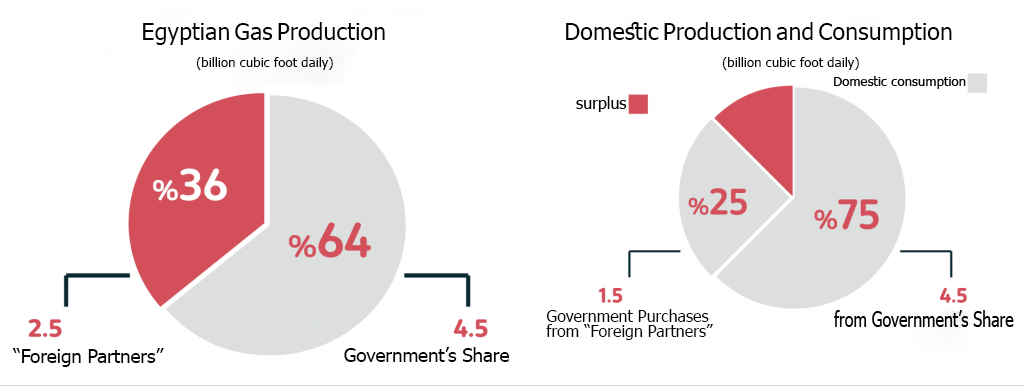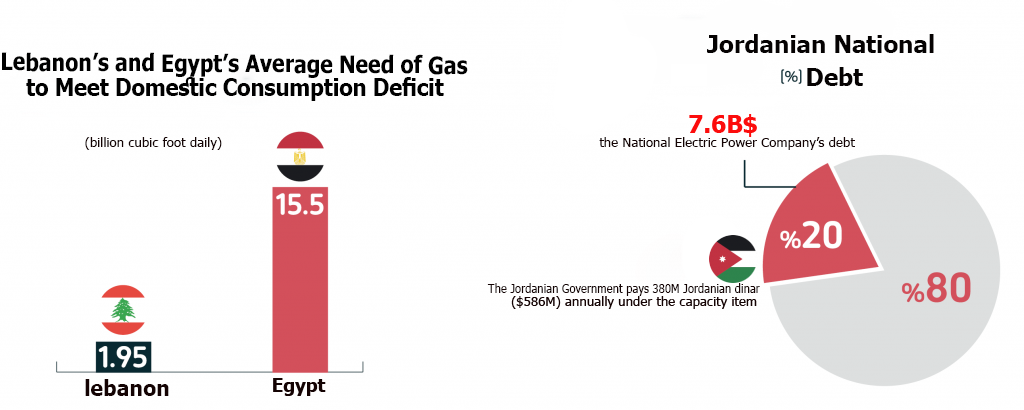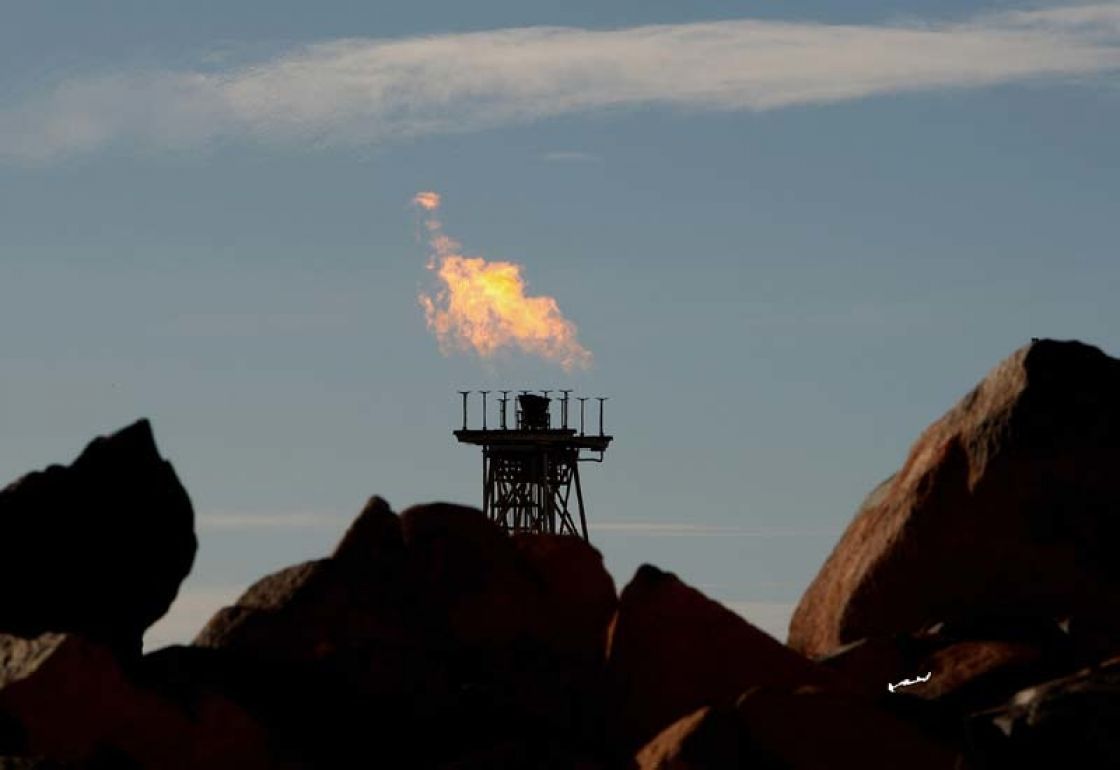- Articles
- Posted
The “Arab” Gas Pipeline… Governments are Merely Facades!
On the surface, the current version of the so-called “Arab gas pipeline” project is being presented as an agreement among a group of Arab governments: Egypt, Jordan, Syria, Lebanon, and with the possibility of plans to include Iraq by way of electricity. However, this is only on the surface, because the scene is completely different for anyone who wants to look deeper.
In recent weeks, Kassioun has published a series of articles and studies about the “Arab” gas pipeline (those can be accessed here: 1, 2 (AR), 3 (AR), 4, 5). In this article, we continue to examine another aspect of the same issue, which can be summed up by the following question: What is the actual role of the governments of Egypt and Jordan in this project, in relation to private domestic and foreign companies engaged in gas and energy, in both countries?
Egyptian gas, but who owns it?
• According to former Egyptian Oil Minister, Osama Kamal, in an interview he did with Economy Plus (AR): “Egypt does not own all the gas it produces, as the government accounts for only two-thirds of what is produced, and the last third is owned by foreign partners, named foreign drilling companies”.
• Egypt’s total natural gas production is 7 billion cubic feet per day, of which 4.5 billion is the Egyptian government’s share. Egypt’s daily domestic consumption is 6 billion feet per day, meaning that the Egyptian government consumes all the gas it produces and buys in addition thereto 1.5 billion cubic feet of gas per day from “foreign partners”.
• In two previous articles (1 (AR), 2), we showed that Egypt had exported 1.8 billion cubic meters of gas last year, while the actual surplus between production and consumption was only 0.7 billion, and that this surplus barely meets Lebanon’s need alone. We also showed that the difference between the export figure and the surplus figure (1.1 billion cubic meters) was probably “Israeli” gas re-exported through Egypt (either in its natural form or after its liquification).
• Based on the statements of the former Egyptian Oil Minister, it is misleading to consider the Egyptian state a gas exporter, albeit modest. This is what the Minister says in a softened way in the aforementioned interview: “The gas exports are coming from Egyptian territory, but its owner may be the foreign partners”. In addition to the what the Minister said, the figures indicate that Egypt in this sense is a net importer of natural gas, Egyptian and non-Egyptian. In other words, it (in addition to importing gas from the Zionist entity through the Ashkelon al-Arish line) buys its deficiency of domestic needs from “foreign partners” working on its territory, and this deficiency reaches 15.5 billion cubic meters per year.
• In order to be able to clarify the meaning of this figure that Egypt buys annually from “foreign partners” to complement its domestic consumption needs, we will make the following comparisons: first, this figure is 25.8%, or about a quarter of Egypt’s gas consumption, i.e., Egypt buys a quarter of its domestic gas consumption from “foreign partners”. Second, this figure accounts for 22% of the total gas produced “originating from Egyptian territory”. Thirdly, we explained in a previous article that assuming Lebanon wants to fill its entire electricity deficit and reach 24 hours of electrical connection per day using only gas, it will need between 1.6 and 2.3 billion cubic meters of gas per year (an average of 1.95 billion cubic meters). That is, Egypt’s need for gas that it buys from “foreign partners” annually for domestic consumption is an average of 8 times Lebanon’s need. Despite that, we are told that Egypt will export gas to Lebanon to “help it solve its crisis”, while the priority – considering the situation – should be that the Egyptian government find ways to fill its internal deficit instead of working as a front for “foreign partners” to export its gas.

Jordanian gas, but who owns it?
• Jordan’s national debt increased (AR) during the first five months of this year to $38.1 billion, which is equivalent to 85.9% of the GDP.
• 20% of this debt (AR), or about $7.62 billion, is owed by Jordan’s “National Electric Power Company”. To correctly understand how Jordan’s electricity sector works, it should be noted that the National Electric Power Company that bears this huge debt has two unique characteristics: 1- it is the only state electric power company in Jordan, and at the same time the only one that incurs losses, while all private electric power companies operating in Jordan are profitable companies. 2- This company does not generate electricity, rather its function is power transportation and control, purchase of electric power produced by private companies and resale thereof to consumers. That is, there is a unique and astounding pattern of electricity privatization in Jordan, where profits and losses are distributed steadily: private companies take profits, and the state company takes losses.
• Engineer Firas al-Ajarma, a Jordanian MP and member of the parliamentary energy committee, explained the loss in a television interview on Jordan’s Roya TV channel on July 28, 2021. He said: “The Jordanian government has been misled by companies and studies by saying that in 2020 Jordan will need 5,000 megawatts of electricity. Agreements unfair to the state’s budget have been signed and now they want the citizen to pay it off”. He continues: “We pay 380 million Jordanian dinars [$536 million] a year for capacity; an item called capacity”. Explaining with an example, he says: “If you have a power company and I [the government] have signed a contract with you, you can give me 200 MW, and I can only take 100 from you, yet I have to give you its price [the price of the 200], whether or not I take it. Some of these contracts run until 2047”.
• To shed more light on the “disinformation” process that al-Ajarma is talking about, it should be noted that it began in 2007 under the title of “reform” as part of a 15-year plan recommended by the International Monetary Fund, which recently introduced a new plan to “reform distortions” (AR) spanning three years from 2021 to 2024 and includes redefining electric power segments and their prices within the goal of “redirecting support to those who deserve it”. The Syrian reader should not be surprised by the expression also used by the Syrian governments, because the instructor and supervisor are the same in all these regimes, which is the IMF and the World Bank, which distribute their recipes to “our” governments.
• What is striking, and perhaps comical, is the IMF and the World Bank being surprised with the results they have planned to reach. According to journalist Reham Zidan (AR): “The World Bank said today [29/5/2021] that Jordan’s electric power sector is paradoxical in terms of reforms, having previously succeeded in attracting new investments in the electric power private sector and then followed that by total economic imbalances related to financial sustainability and debt accumulation”. This paradox, which the World Bank speaks of in a convoluted manner as usual, is the same as the one we talked about earlier: success and profits are the share of private companies, and losses are the share of the Jordanian Government and people.
• Going back to the substance of the issue we are discussing, targeting the increase in the installed capacity in Jordan to numbers that exceed the needs of domestic consumption, at the expense of the government and subsequently the Jordanian people, as evidenced by the above, is planned for for many years, but why?
• Whoever started in 2007 with plans to raise the installed capacity in Jordan to redirect it towards export, raised it based on knowing that there would be a rise in regional demand for electric power. Going back to that date, Syria, Lebanon, and Iraq have not suffered from major electricity crises. That is, the owners of these schemes had preemptively anticipated the systematic destruction of the region, or at best had benefited from the “historic opportunity” of systematic destruction that followed.
• In essence, those preparing to become an electric power exporter are certainly not Jordan as a country, not Jordan as a government, but a group of private companies, whose actual owners are difficult to track. More importantly, the key partner and profiteer in this process is revealed by the fact that 88% of Jordan’s electric power generation process, as noted in a previous article, is carried out using imported raw energy. We had shown that there was a near-perfect match between the figure Jordan pays annually to import raw energy for electric power production (about $686 million) and the estimated value of the price of gas Jordan imports annually from “Israel” (about $666 million).
• Like the Egyptian gas situation, the Jordanian government is emerging on the issue of electricity as a front for the private domestic and foreign sector, and even itself pays (of course from the pockets of Jordanians) for this process, leaving its profits to “domestic” and “foreign” partners. All of this is under the auspices and recommendations of the World Bank and the International Monetary Fund.
• Linking with the previous articles, it is difficult to see all these data without wondering about the relationship of the occupying (Zionist) entity to the project as a whole, not only in terms of “seizing the immediate historical opportunity”, but also in preparing for it.



